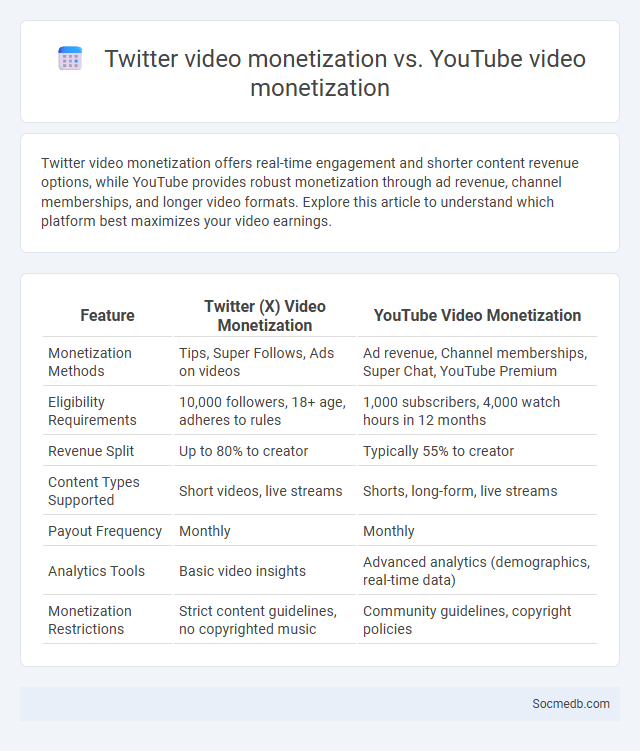
Photo illustration: Twitter video monetization vs YouTube video monetization
Twitter video monetization offers real-time engagement and shorter content revenue options, while YouTube provides robust monetization through ad revenue, channel memberships, and longer video formats. Explore this article to understand which platform best maximizes your video earnings.
Table of Comparison
| Feature | Twitter (X) Video Monetization | YouTube Video Monetization |
|---|---|---|
| Monetization Methods | Tips, Super Follows, Ads on videos | Ad revenue, Channel memberships, Super Chat, YouTube Premium |
| Eligibility Requirements | 10,000 followers, 18+ age, adheres to rules | 1,000 subscribers, 4,000 watch hours in 12 months |
| Revenue Split | Up to 80% to creator | Typically 55% to creator |
| Content Types Supported | Short videos, live streams | Shorts, long-form, live streams |
| Payout Frequency | Monthly | Monthly |
| Analytics Tools | Basic video insights | Advanced analytics (demographics, real-time data) |
| Monetization Restrictions | Strict content guidelines, no copyrighted music | Community guidelines, copyright policies |
Overview of Video Monetization Platforms
Video monetization platforms enable content creators to generate revenue through advertisements, subscriptions, or direct viewer payments. Popular platforms like YouTube, TikTok, and Twitch offer diverse monetization options including ad revenue sharing, sponsored content, and fan contributions. Your success on these platforms depends on understanding each platform's unique requirements and leveraging audience engagement effectively.
How Twitter Video Monetization Works
Twitter video monetization enables content creators to earn revenue through ads placed within their videos, leveraging Twitter's Amplify Publisher Program. Creators can share revenue generated from pre-roll or mid-roll ads when tweets containing videos receive significant engagement and views. Audience metrics and advertiser demand influence earnings, with eligibility requiring content adherence to Twitter's monetization policies and a minimum follower count.
YouTube Video Monetization Explained
YouTube video monetization enables creators to earn revenue through ads, channel memberships, Super Chats, and YouTube Premium revenue. Understanding the YouTube Partner Program requirements, such as having 1,000 subscribers and 4,000 watch hours in the past 12 months, is essential for activating monetization features. You can maximize your earnings by optimizing video content, engaging with your audience, and complying with YouTube's monetization policies.
Creator Monetization: Beyond Traditional Platforms
Creator monetization has expanded beyond traditional platforms like YouTube and Instagram, empowering you to diversify income streams through emerging channels such as NFTs, subscription-based services, and decentralized social networks. These innovative methods enable direct fan engagement and revenue generation without reliance on ad-based models or platform algorithms. Tapping into blockchain technology and community-driven ecosystems allows creators to retain greater control over their content and earnings.
Eligibility Requirements Comparison
Eligibility requirements for social media platforms vary significantly, with most demanding users to be at least 13 years old to comply with COPPA regulations. Platforms like Facebook and Instagram also require a valid email address or phone number for account verification, ensuring genuine user identities. Adjusting Your social media strategy based on these criteria can optimize account setup and compliance.
Revenue Share Models: Twitter vs YouTube vs Others
Twitter's revenue share model primarily involves its Amplify program, offering content creators up to 70% of advertising revenue from pre-roll ads, while YouTube provides an average of 55% ad revenue share through its Partner Program. Compared to platforms like TikTok, which offers approximately 50% revenue share through its Creator Fund and Live Gifts, YouTube remains the most lucrative for creators focused on ad-based income. Emerging platforms vary widely, but Twitter and YouTube set benchmarks with transparent monetization structures and scalable monetization options for influencers and content producers.
Ad Formats and Monetization Opportunities
Social media platforms offer diverse ad formats including native ads, video ads, carousel ads, and sponsored posts, enhancing user engagement and brand visibility. Monetization opportunities extend beyond traditional ads to influencer partnerships, affiliate marketing, and in-app purchases, enabling creators and businesses to generate significant revenue streams. Advanced targeting algorithms and data analytics optimize ad delivery, increasing conversion rates and ROI for advertisers.
Audience Engagement and Earning Potential
Social media platforms maximize audience engagement by leveraging personalized content algorithms that increase user interaction and time spent on posts. High engagement rates boost brand visibility, leading to expanded follower bases and stronger community loyalty. This amplified reach and interaction directly enhance earning potential through sponsored posts, affiliate marketing, and e-commerce integrations.
Payout Processes and Timelines
Social media platforms implement structured payout processes to ensure timely and accurate compensation for content creators and influencers, often involving a minimum earning threshold before payments are released. Typical payout timelines range from monthly to quarterly, with platforms like YouTube processing payments through AdSense within 21 days after the end of the payment period. Understanding the specific payout schedule, including processing delays and preferred payment methods, is crucial for users to manage their cash flow efficiently.
Which Platform is Best for Creators?
YouTube remains the best platform for creators seeking robust monetization options and a diverse audience, with over 2 billion logged-in monthly users and revenue-sharing through ads, memberships, and merchandise. TikTok rapidly grows in popularity, especially among younger audiences, offering viral content exposure and creator funds but with less direct monetization compared to YouTube. Instagram supports visual creators with features like Stories, Reels, and Shopping, ideal for brand partnerships and influencer marketing within its 2 billion active users.
 socmedb.com
socmedb.com